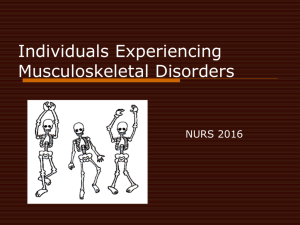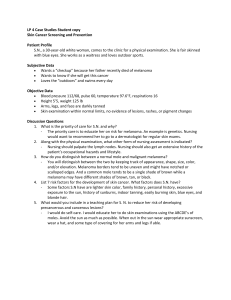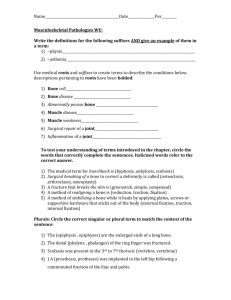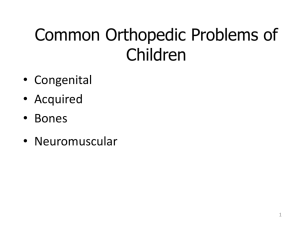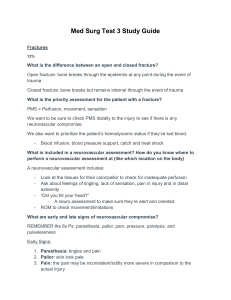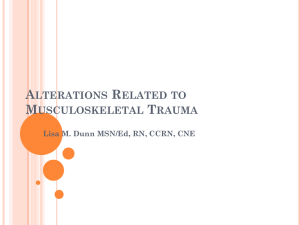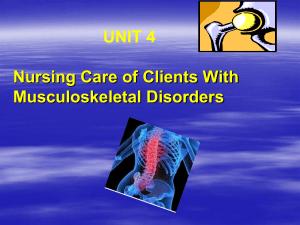Orthopedic Measures
advertisement
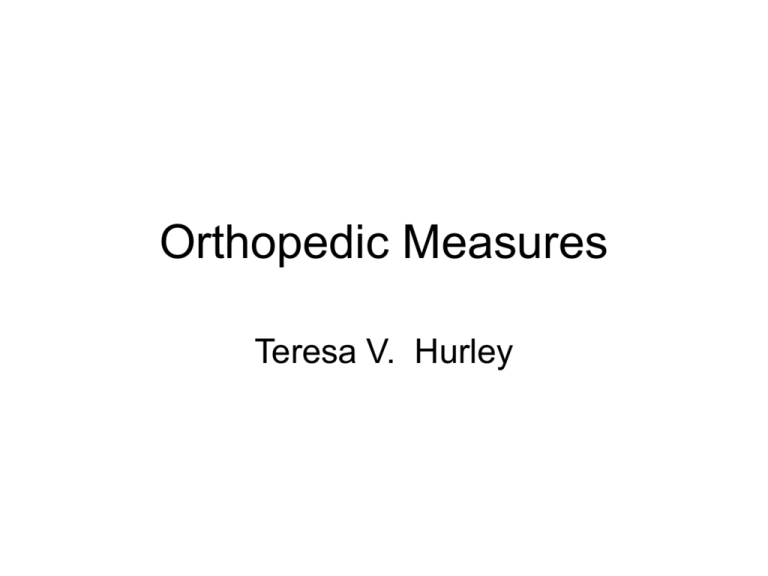
Orthopedic Measures Teresa V. Hurley Fractures • What is a fracture? Fractures • A disruption or break in the bone from: – Trauma or pathology Immediate Intervention: RICE R = rest and limit movement I = ice C = compression to reduce swelling E = elevate above heart level Classification • A. Type • B. Communicated or noncommunicated • C. Anatomic Location Types • Comminuted: more than two fragments/floating appearance • Displaced: fragment overrides the other bone fragment • Greenstick: incomplete; one side splintered the other side bent • Impacted: comminuted with more than 2 fragments are driven into each other Types Continued • Longitudinal: incomplete; fx line along the longitudinal axis of bone • Oblique: line of fx extends in oblique direction • Spiral: fx line is spiral along the bone shaft • Transverse: fx line across bone shaft at right angle to longitudinal axis • Pathological: spontaneous at site of disease Fractures Continued • Open FX: (compound) communication through skin to the outside; or from outside to within • Closed Fx: noncommunication Signs and Symptoms • • • • • Pain Muscle spasms Deformity Ecchymosis Loss of function – Inability to bear weight or use • Guarding behavior • Crepitation KEEP IN POSITION FOUND TO PREVENT TISSUE AND/OR NEUROVASCULAR DAMAGE; OR CLOSED TO OPEN FX Immobilization of Fractures • Casts – Usually after closed reduction (non-surgical) – Plaster of paris, synthetic, fiberglass free, latex-free polymer, hybirds – Complete drying within 24 to 72 hours (hair dryer) – Prevent soiling, wetness, stress – Handle by palms of hand to prevent finger indications which are a source of pressure – Petal rough edges with water-proof tape to prevent skin breakdown from edges and cast crumbs Traction • Pulling force applied to affected part and counter traction applied in the opposite direction – Prevent or reduce muscle spasm – Reduce fracture or dislocation – Prevent soft tissue damage by immobilization Traction Types • Skin: adhesives directly to skin which is wrapped with bandages or slings, belts or splints attached to rope with weights • Skeletal: directly to bone with wires and pins Skin Traction Types • • • • • • Bucks Rusell’s Bryant’s Pelvic Belt Pelvic Sling Head Halter Skeletal Traction Types • Overhead arm [90 degrees] • Lateral Arm • Balanced Suspension Union: Bone Healing Process • • • • • • Hematoma Granulation tissue Callus Ossification Consolidation Remodeling Critical Nursing Assessments Neurovascular Assessment performed on both extremities and compared to each other Peripheral Vascular Assessment -color (pink, pale, cyanotic) -temperature (hot, warm, cool, cold) -capillary refill (blanching within 3 seconds; or delayed) -peripheral pulses (strong. diminished, absent) or absent) -edema (pitting) Critical Nursing Assessments • Peripheral Neurologic Assessment – Sensation (parathesias, numbness, tingling, decreased or increased sensation, partial (paresis) or full (paralysis) loss – Motor function (motion and strength – Pain (location, quality, intensity use a scale from 0 to 10) Complications • Infection • Compartment Syndrome – Pressure within the myofascial space effects the neurovascular tissues which may lead to necrosis – Examples of etiologies • Dressings, splints, traction • Bleeding, edema, snakebites, IV infiltration • Fractures, crush injuries, burns SIX P’s of Impending Compartmental Syndrome • Paresthesis (numbness and tingling) • Pain distal to injury not relieved by analgesics; positive Homan’s sign • Pallor • Paralysis • Pressure • Pulselessness Complications • Fat Embolism Syndrome (24 to 48 hr after injury) – Acute respiratory distress – Chest pain, tachypnea, cyanosis, dyspnea, tachycardia, decrease Sp02, mental status changes, restlessness, headaches, confusion Nursing Diagnoses • Risk for Peripheral Neurovascular Dysfunction r/t nerve compression • Goal: Client will not exhibit neurovascular impairment • Assess for the 6 P’s • Elevate extremity above heart level • Apply ice compresses • Notify MD if c/o of increasing pain unrelieved by analgesics Nursing Diagnoses • Acute Pain r/t edema, muscle spasms, bone fragments • Goal: Client will have less pain • Move extremity gently • Scale to assess pain and evaluate effectiveness of measures • Elevate extremity, apply ice and support • Administer prescribed analgesics and muscle relaxants • Report increasing pain to MD unrelieved by analgesics Nursing Diagnoses • Risk for Impaired Skin Integrity r/t casted extremity and immobility • Goal: Client will not exhibit skin breakdown • Assess potential areas • Petal edges of cast • Assess exposed skin areas of traction sites for pressure producing necrosis Nursing Diagnosis Continued • Instruct client not to insert items into cast as hangers, eating and cooking utensils, to scratch; use meat baster to puff air • Instruct client to report areas of warmth, pain, burning, moisture, foul odor and areas of increasing drainage
